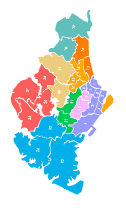| About Singapore |
| Tour Packages |
| What to do |
| What to see |
| Where to Stay |
| Events |
| Contact us |
Singapore is a huge city with several district articles containing sightseeing, restaurant, nightlife and accommodation listings - consider printing them all.
Singapore (新加坡) is a city-state in Southeast Asia. Founded as a British trading colony in 1819, since independence it has become one of the world's most prosperous countries and boasts the world's busiest port. Combining the skyscrapers and subways of a modern, affluent city with a medley of Chinese, Malay and Indian influences and a tropical climate, with tasty food, good shopping and a vibrant night-life scene, this Garden City makes a great stopover or springboard into the region.
History
The first records of Singapore date back to the second and third centuries where a vague reference to its location was found in Greek and Chinese texts, under the names of Sabana and Pu Luo Chung respectively.
According to legend, Srivijayan prince Sang Nila Utama landed on the island and, catching sight of a strange creature that he thought was a lion, decided to found a new city he called Singapura, Sanskrit for Lion City, c. 1299. Alas, there have never been any lions anywhere near Singapore (until the Singapore Zoo opened) or elsewhere on Malaya in historical times, so the mysterious beast was more probably a tiger or wild boar.
More historical records indicate that the island was settled at least two centuries earlier and was known as Temasek, Javanese for "Sea Town", and an important port for the Sumatran Srivijaya kingdom. However, Srivijaya fell around 1400 and Temasek, battered by the feuding kingdoms of Siam and the Javanese Majapahit, fell into obscurity.
As Singapura, it then briefly regained importance as a trading centre for the Melaka Sultanate and later, the Johor Sultanate. However, Portuguese raiders then destroyed the settlement and Singapura faded into obscurity once more.
The story of Singapore as we know it today began in 1819, when Sir Thomas Stamford Raffles made a deal with a claimant to the throne of the Sultanate of Johor: the British would support his claim in exchange for the right to set up a trading post on the island.
Though the Dutch initially protested, the signing of the Anglo-Dutch treaty in 1824, which separated the Malay world into British and Dutch spheres of influence (resulting in the current Malaysia-Indonesia and Singapore-Indonesia borders), ended the conflict. The Dutch renounced their claim to Singapore and ceded their colony in Malacca to the British, in exchange for the British ceding their colonies on Sumatra to the Dutch.
Bored proboscis monkey, Singapore Zoo Well-placed at the entrance to the Straits of Malacca, straddling the trade routes between China, India, Europe, and Australia, Raffles' master stroke was to declare Singapore a free port, with no duties charged on trade. As traders flocked to escape onerous Dutch taxes, the trading post soon grew into one of Asia's busiest, drawing people from far and wide. Along with Penang and Malacca, Singapore became one of the Straits Settlements and a jewel in the British colonial crown. Its economic fortunes received a further boost when palm oil and rubber from neighbouring Malaya were processed and shipped out via Singapore. In 1867, Singapore was formally split off from British India and made into a directly ruled Crown Colony.
When World War II broke out, Fortress Singapore was seen as a formidable British base, with massive naval fortifications guarding against assault by sea. However, not only did the fortress lack a fleet, as all ships were tied up defending Britain from the Germans, but the Japanese wisely chose to cross Malaya by bicycle instead!
Despite hastily turning the guns around, this was something the unimaginative British ruling class had not prepared for at all, and on 15 Feb 1942, with supplies critically low after less than a week of fighting, Singapore's colonial masters ignominiously surrendered. The colony's erstwhile rulers were packed off to Changi Prison. Tens of thousands perished in the subsequent brutal Japanese occupation. The return of the British in 1945 was triumphalist.
Granted self-rule in 1955, Singapore briefly joined the Malaysian Federation in 1963 when the British left, but was expelled because the Chinese-majority city was seen as a threat to Malay dominance. The island became independent on 9 August 1965, thus becoming the only country to gain independence against its own will in the history of the modern world!
The subsequent forty years rule by Prime Minister Lee Kuan Yew saw Singapore's economy boom, with the country rapidly becoming one of the wealthiest and most developed in Asia despite its lack of natural resources, earning it a place as one of the four East Asian Tigers. Now led by Lee's son Lee Hsien Loong, the ruling People's Action Party (PAP) continues to dominate the political scene with 81 out of 87 seats in Parliament. Societal restrictions have been loosened up in recent years though, with the government trying to shake off its staid image, and it remains to be seen how the delicate balancing act between political control and social freedom will play out.
Go to Sri Lanka Thailand Singapore
| Home | About us | Manage Booking | Privacy Policy | Terms and Conditions |
|
|||
| Copyright 2013 tatbooking.com - All rights reserved | Design by AYSEL | |||


